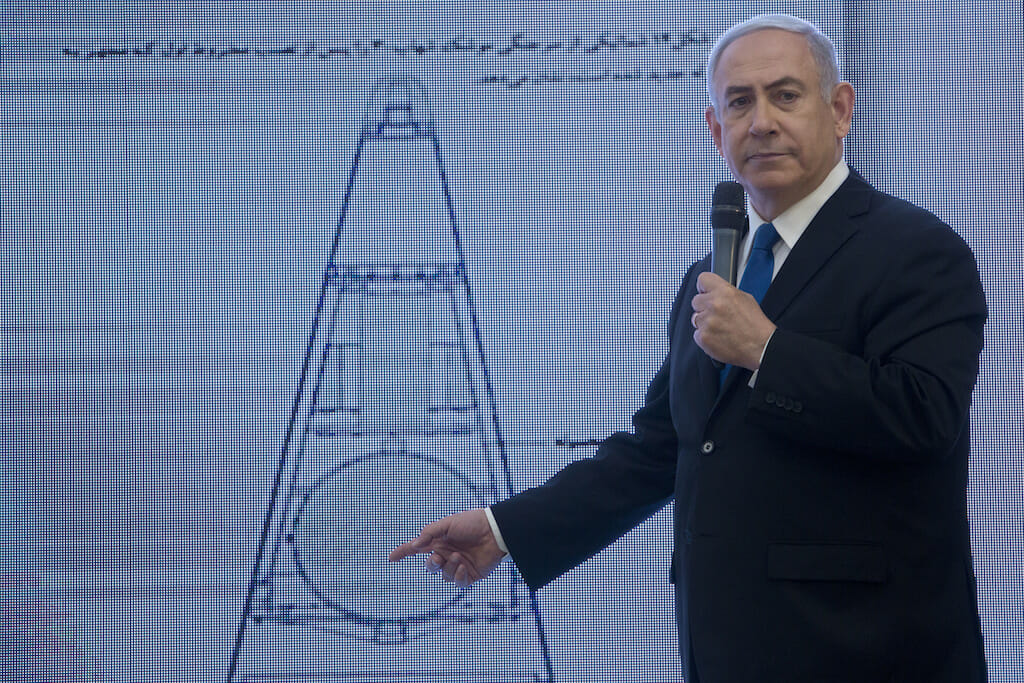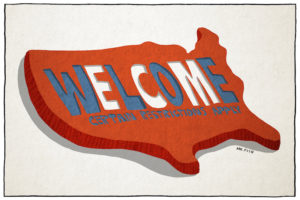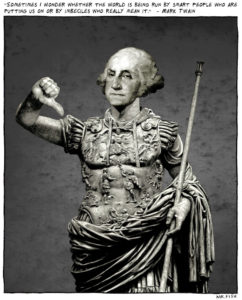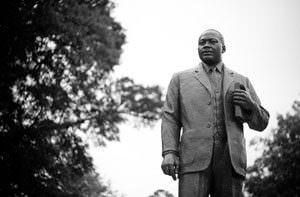Bibi’s Information Warfare Operation Against America
Benjamin Netanyahu's presentation on Iran's alleged nuclear weapons program was all smoke and mirrors to influence President Trump. Israeli Prime Minister Benjamin Netanyahu presents material on Iranian nuclear weapons development during a news conference in Tel Aviv. (Sebastian Scheiner / AP)
Israeli Prime Minister Benjamin Netanyahu presents material on Iranian nuclear weapons development during a news conference in Tel Aviv. (Sebastian Scheiner / AP)
Israeli Prime Minister Benjamin Netanyahu understands the power of framing a story. On April 29, he gave a televised presentation and revealed, in dramatic fashion, the existence of an alleged archive of documents, drawings and photographs that proved Iran once had a program dedicated to the acquisition of a nuclear weapon, contrary to public claims that senior Iranian officials made in the past.
The relevance of Netanyahu’s message is up for debate. Most observers acknowledge the exposé may prove embarrassing to the International Atomic Energy Agency (IAEA) and Iran, which together certified in December 2015 that all issues pertaining to the so-called “possible military dimensions” of the Iranian nuclear program had been resolved. But there is unanimous agreement that nothing in Netanyahu’s presentation shows Iran is operating in violation of its commitments under the agreement reached with the permanent members of the United Nations Security Council, Germany and the European Union regarding its ongoing nuclear activities (formally known as the Joint Comprehensive Program of Action, or JCPOA.)
While Netanyahu hailed the work of the Israeli intelligence service (Mossad) in acquiring the Iranian archive, the narrative Israel has promulgated about this archive and how it came into its possession is less than convincing. Upon closer scrutiny, what emerges is less about the covert collection of secret information and more about manipulating opinion. Netanyahu’s presentation could have been an episode of a Donald Trump reality television show, since the Israeli prime minister was performing for an audience of one—the American president.
On May 12, Trump will announce his decision on whether the United States will remain a party to the JCPOA. Was Netanyahu’s revelation a legitimate function of a sovereign state that, armed with alarming new information pertaining to international peace and security, opted to publicly expose this threat? Or were the motives more nefarious, with the Israeli prime minister intending to manufacture a case for which there was no substantive supporting documentation in order to manipulate the policies of another country?
Upon closer examination of the issue, the answer becomes clear: Netanyahu was conducting a classic information operation against the American president and, by extension, the American people.
The mission of any intelligence-driven psychological warfare/information operations effort is to manipulate public opinion to support controversial foreign policy and/or national security policies and decisions. Intelligence is either cherry-picked or manufactured and then selectively released to the public at a time most beneficial to the policy objective being supported.
I have considerable personal experience in this sort of operation. From 1994 through 1998, while serving as a weapons inspector with the United Nations Special Commission on Iraq, I had a front-row seat to the inner workings of the Israeli intelligence service when it came to the conduct of the full spectrum of intelligence operations against Iraq. During this time, I witnessed the good, the bad and the ugly of how Israel collects and analyzes intelligence information. I sat in on discussions with the head of Aman (the Israeli military intelligence service) as options regarding the proper utilization of this intelligence were discussed.
I can attest that as long as Israel viewed the work of U.N. inspectors as being useful in furthering its national security objectives—namely, when the U.N. was seen as a viable instrument of eliminating Iraqi weapons of mass destruction—its intelligence services engaged in classic intelligence work. They gathered information about Iraq using a wide range of intelligence collection capabilities and conducted analysis designed to produce intelligence assessments geared toward discovering the truth about Iraq’s proscribed capabilities. This information, and Israel’s role in producing it, was shrouded in secrecy, as is normally the case when a nation does legitimate intelligence work.
In the fall of 1997, the intelligence war between the U.N. inspectors and Iraq shifted away from the search for hidden weapons of mass destruction capabilities inside Iraq and moved to the corridors of the United Nations itself, where a public relations war was being waged between the supporters of the weapons inspection process and the supporters of Iraq.
Until this time, the U.N. weapons inspectors had operated in the shadows, the details of their work hidden from public scrutiny. However, once the Iraqis and their allies turned the tables on this shroud of secrecy, accusing the inspectors of being little more than a front for intelligence services hostile to Iraq (rightly so, it turned out), the mission of the inspectors shifted away from searching for the truth on the ground in Iraq to shaping public opinion around the world about the nature of their work. The CIA worked hand in glove with the U.N. inspectors and CNN to produce a program dedicated to Iraqi concealment and deception, while the British MI6, through a project known as “Operation Mass Appeal,” used intelligence information in the possession of the inspectors but deemed to be of insufficient quality to support an inspection, to seed stories to compliant journalists around the world for the purpose of shaping public opinion. This was classic information operations/psychological warfare, and I played a central role in its conduct.
At first, Israel stood on the sidelines, working with U.N. inspectors to finish the job on the ground inside Iraq. But as the U.N. disarmament effort in Iraq became more about the political and economic isolation of the regime of Saddam Hussein (in preparation for eventual regime change in Baghdad) and less about bringing closure to the disarmament of Iraq’s WMD capability, Israel saw the light. Realizing the Security Council was no longer going to permit U.N. weapons inspectors to carry out aggressive inspections inside Iraq, Israel pulled its support from the inspection process, and aligned itself with those in the business of preparing public opinion for a war with Iraq. This required Israel to do a 180-degree turnaround regarding its intelligence-driven assessment of Iraqi WMD capabilities.
In the spring of 1998, when I met with Amos Gilad, the new head of Aman’s research division (responsible for the production of Israel’s national intelligence estimates), he indicated that, thanks to the work of U.N. inspectors, Israel assessed that Iraq’s WMD programs had been eliminated. Four years later, on the eve of the American-led invasion of Iraq, Gilad changed his mind, claiming that Iraq had both chemical and biological weapons, long-range missiles to deliver them and a nuclear weapons program in the first stages of development.
This wasn’t Gilad’s first experience with manipulating intelligence for political objectives. During the time of the Camp David accords in 2000, Gilad led a campaign to undermine the credibility of PLO leader Yasser Arafat by painting him as a proponent of Palestinian unrest designed to harm Israel. The intelligence information Israel gathered showed the exact opposite to be the case. Gilad, however, was operating not in support of the truth, but rather the political ambition of then-Prime Minister Ehud Barak, whose campaign slogan at the time was, “There is no partner for peace.” Gilad, later investigations showed, had doctored the intelligence in order to paint a false and misleading picture of on-the-ground truth.
Amos Gilad spent 45 years in the service of Israeli intelligence, retiring in 2017. According to Gilad, his proudest achievement during his career was the role he played in getting Iran identified as the main threat to Israel, back in 1996. (I can verify this, since I was told personally by the then-head of Aman, Moshe Ya’alon, that, thanks in large part to the work done by U.N. inspectors, Iraq had dropped to number five on the list of threats to Israeli security, behind Iran, Hezbollah, Palestine and Israel’s ultraconservative Orthodox Jews.)
When Benjamin Netanyahu was first elected prime minister of Israel, in 1996, Amos Gilad briefed him on the intelligence assessment that placed Iran as Israel’s main threat. Netanyahu went on to speak before the U.S. Congress in July 1996, telling American lawmakers that the fundamental problem in the Middle East was “unreconstructed dictatorships whose governmental creed is based on tyranny and intimidation,” adding that “[the] most dangerous of these regimes is Iran, that has wed a cruel despotism to a fanatic militancy. If this regime, or its despotic neighbor Iraq, were to acquire nuclear weapons, this could presage catastrophic consequences, not only for my country, and not only for the Middle East, but for all mankind.”
Netanyahu’s speech, when combined with Israeli intelligence reports Gilad carefully manipulated and selectively released to the press, played an important role in getting Congress and the administration of then-President Bill Clinton to sanction Iran in September 1996.
Netanyahu has been the mouthpiece of Israeli information operations/psychological warfare for more than 20 years. In the summer of 2002, after being voted out of office, private citizen Netanyahu—drawing upon the credibility he would be given as a person who had, only recently, been privy to Israeli intelligence information Gilad provided—testified before Congress that “every indication is that he [Saddam Hussein] is pursuing, pursuing with abandon, pursuing with every ounce of effort, the establishment of weapons of mass destruction, including nuclear weapons.” History proved Netanyahu, and the information he was relying on, to be 100 percent wrong.
The thing about intelligence-driven information operations, however, isn’t the need to get the information right. The goal is to get the policy right, and in this case, Israel’s policy objective of getting the United States to invade Iraq and remove Saddam Hussein from power was achieved.
Netanyahu has been at the forefront of Israeli information operations targeting Iran. For years, he lectured the world about the danger Iran’s nuclear program posed, culminating in a bizarre show-and-tell before the United Nations in 2012 where he used a crude drawing of a bomb to illustrate his case. The takeaway from Netanyahu’s speech, however, did not rest with any spectacular expose of Iranian nuclear ambition, but the fact that Netanyahu was freelancing—the Israeli intelligence service did not agree with the case the Israeli prime minister was making. Since that time, Netanyahu has doubled down on crying wolf about the Iranian nuclear threat, opposing at every step the Obama administration’s efforts to negotiate a nuclear deal with Iran, and supporting Donald Trump’s calls to “rip up” that same agreement.
Given both Israel’s past role in exaggerating the Iraqi WMD threat and Netanyahu’s track record on the issue of Iran and its nuclear program, a responsible observer would be loath to take the Israeli prime minister’s warnings at face value. Instead, one would insist on a process of verification to be conducted on the documents and data the Israeli prime minister relied upon to make his case.
I have considerable experience in conducting searches for documentary evidence involving weapons of mass destruction. I was in the U.N. operations center when U.N. inspectors seized the Iraqi nuclear files in September 1991 and headed up the inspections that cornered a covert Iraqi WMD archive in the summer of 1992. Between 1995 and 1996, I led the investigation into the so-called “chicken farm” archive Iraq turned over to inspectors following the defection of Hussein Kamal in August 1995. I am intimately familiar with the logistics of covertly gathering, collating, archiving and securing a massive number of documents and associated materials. The “chicken farm” archive itself was more than a million pages—more than 10 times larger than the document cache alleged to have been stolen by the Mossad. I spent months debriefing the Iraqi security personnel involved with transporting and securing this archive, as well as physically inspecting the locations involved, and have gained some insight into the realities associated with such operations.
According to Israeli sources, operatives of the Mossad discovered the location of the Iranian nuclear archive sometime in 2016, after it had been moved into a ramshackle warehouse in southern Tehran. In early 2017, Israeli operatives were able to gain access to the building, access the material in question and remove it from Iran the same day. These same sources state that a special unit of the Iranian Intelligence Service guarded the archive. If the Israeli story is true, then the Israelis exposed an entire operational network for the purpose of bringing this information to public attention, an act that, given the time and difficulty of putting such a network in place, borders on the criminally irresponsible.
I do not doubt that the Israelis would be able to gather information about the existence and location of a secret archive in Iran. In my time as an inspector, I received numerous reports of this nature, which proved to be both timely and accurate. The issue is access. In Iraq, we had a full-time inspection apparatus mandated to carry out document searches and, as such, could operate openly. In my debriefs of the Special Republican Guard officers who had been given the task of safeguarding the “chicken farm” archive, they indicated that they had a 24-hour armed presence, and that they would have shot and killed anyone—even U.N. inspectors—who tried to gain access to these documents. If the Iranian archive is as sensitive and important as Netanyahu claims, and indeed a special unit of the Revolutionary Guard was assigned the task of securing this archive, there is no doubt that the same “shoot to kill” orders would have been in place, along with a 24-hour armed guard. The thought that Mossad operatives could gain access to the archive and extricate tens of thousands documents and scores of CDs flies in the face of the notion that the archive was sensitive and guarded by elite guards.
That means the documents were forgeries. Who forged them is unknown, but the point is, Israel knows they are not the real deal.
The issue of document verification is critical when addressing the veracity of the information contained in the documents in question. This is another area where I possess some relevant experience. By way of example, in 1992 U.N. weapons inspectors compelled the Iraqi government to admit that it had lied about the numbers of missiles it had declared. Nearly 100 missiles had been hidden from inspectors, and the accounting used to underpin the original deceptive figures was doctored to make up for the missing missiles. To clear up this discrepancy, the Iraqis provided the inspectors with detailed log books from the Iraqi Army that recorded the disposition of every missile received from the Soviet Union. To verify that these were original logbooks, and not forgeries produced to deceive the inspectors, the inspectors turned over one of the original logbooks to the FBI so that a forensic assessment could be made.
The FBI was able to determine the type of paper used in the logs, trace the paper back to its source and confirm that this paper had been provided to Iraq during the time period involved, Similarly, the FBI conducted a forensic analysis of the ink used in typing up the documents, identifying specific typewriters involved, as well as the inks used for the various stamps and signatures that had been affixed to the documents in question. The conclusion reached by the FBI was that the documents were most likely originals.
Likewise, when U.N. inspectors came upon computerized files, the files were subjected to detailed forensic analysis to ascertain whether they were originals, or copies planted to deceive the inspectors. This analysis—which included determining the date a file was created, on which machine it was created, who created it, and any modifications made to the file—was essential in determining the origin of the files (whether they were original) and the veracity of their content. This kind of detailed forensic inspection of documentary evidence was a prerequisite action before any consideration could be made about the validity and credibility of the data. And because of this kind of attention to detail, U.N. inspectors were able to present their document-based findings with confidence.
Netanyahu claimed the documents the Mossad allegedly stole had been shared with the United States and that the United States could vouch for their authenticity, but this claim is, on its face, unbelievable. The Mossad already had accessed many of these documents and found them wanting. Sometime in 2004, the Mossad had gained access to some of the same documents that Netanyahu had used in his April 2018 presentation. These documents were collated into electronic form and turned over to an Iranian opposition group, the MEK (People’s Mujahedeen of Iran), which turned the laptop containing the documents over to the German intelligence service.
That the Israelis went to such lengths to distance themselves from the laptop material raises several issues about the documents themselves. Israel had a long history of providing intelligence directly to the IAEA. I was present on several occasions when Israeli intelligence officers handed over intelligence on Iraq to IAEA inspectors in Vienna, and I ran an intelligence-sharing relationship between the U.N. and Israel that lasted four years. Israel also had an active intelligence-sharing relationship with many IAEA member states, including the United States, Germany and others. The need to disguise the source of the laptop material for operational security reasons is not believable in this regard.
If Israel had identified itself as the source of the information contained in the laptop, then questions would have arisen concerning the source and authenticity of the documents that Israel was not prepared or willing to answer. By using the MEK as a front for the documents, the Israelis avoided having to be held accountable for the inconvenient details and inconsistencies in the documents that eventually exposed them as forgeries, while at the same time being able to plant a seed of doubt within the IAEA that could be leveraged to the detriment of Iran. This was the sole purpose of the laptop documents—to conduct an information operation against Iran.
The documents contained in the laptop played a central role in shaping the IAEA’s so-called “possible military dimension” investigation that was used to push the Iranian nuclear issue out of the IAEA and into the U.N. Security Council, where economic sanctions could be brought into play. It was only in October 2015, after the IAEA and Iran consulted extensively about the information contained in these and other documents, that the issue was dropped.
Many of the key documents Netanyahu used in his presentation were familiar to former IAEA officials, including Olli Heinonen (who ran inspections in Iran and had been the point man on getting the laptop documents injected into the IAEA case against Iran). These documents were also familiar to American officials, including Thomas Countryman, the former State Department official responsible for international security and nonproliferation. Both Heinonen and Countryman link these documents to the document trove contained on the 2004 laptop, which contained demonstrable forgeries. Void of any forensic report on the size, shape, format, markings, signatures, paper and ink that comprise each individual document (the kind of details that exposed several of the laptop documents as crude forgeries), or a similarly detailed digital forensic report on the electronic media, there simply is no vouching for the authenticity of the documents in question. At best, the United States can say that these documents come from the same source that produced the forged documents that appeared on the 2004 laptop.
It is here that the logic underpinning Netanyahu’s briefing collapses: Why would the Iranians maintain an archive of forged documents? Why would Netanyahu orchestrate a briefing whose content is so readily dismissed?
The answer is clear, once one strips away the pretense of an actual intelligence collection operation. These were not documents stolen away from a deceitful Iran. These documents were already in the possession of Israel (which ostensibly oversaw their creation), for which Netanyahu concocted an elaborate cover story so that they could be shared publicly as part of a classic information operation designed, best case, to sway American public opinion and, at a minimum, the opinion of one man—President Trump, who on May 12 will make a final decision on whether to stay in the Iran nuclear agreement. Netanyahu’s gambit was designed to apply pressure on President Trump to offset counsel from France, Germany, Britain and other allies to keep the agreement alive.
It was a classic psychological warfare operation—all smoke and mirrors—designed not for durability, but maximum short-term impact. Given the limited attention span of the intended audience, the move has a good chance at succeeding.
Your support matters…Independent journalism is under threat and overshadowed by heavily funded mainstream media.
You can help level the playing field. Become a member.
Your tax-deductible contribution keeps us digging beneath the headlines to give you thought-provoking, investigative reporting and analysis that unearths what's really happening- without compromise.
Give today to support our courageous, independent journalists.





You need to be a supporter to comment.
There are currently no responses to this article.
Be the first to respond.